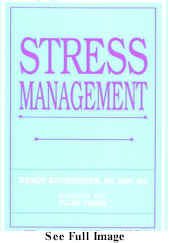|
Stress Management |
After completing the course, you’ll be able to:
-
Describe the stress cycle.
-
Explain the body-mind interaction to stress.
-
Define and give examples of direct and palliative coping techniques.
-
Describe components of wellness and how wellness relates to stress.
-
Discuss how stress management can affect college students.
-
Give examples of a specific stressor and a coping response.
-
Explain the Yerkes-Dodson law.
-
Complete a personal stress cycle diagram.
-
Describe the fight-or-flight response in terms of the nervous and endocrine system.
-
Describe several physiological reactions to stress: specifically from the
-
a) sympathetic nervous system. b) autonomic nervous system c) reticular formation, and d) adrenal medulla
-
Describe the ways stress affects the cardiovascular system.
-
Explain how stress may lead to various illnesses.
-
Give examples of stress-related musculoskeletal problems.
-
Describe how stress interrelates with the immune system.
-
Discuss the Type A behavior pattern.
-
Measure personal stress events and abilities to cope using various assessments.
-
Develop and complete a detailed personal stress log.
-
Develop and implement a stress management action plan.
-
Describe several common strategies for coping with stress and their respective benefit and uses.
-
Explain Lazarus and Folkman’s model of stress and coping.
-
Define problem orientation.
-
Describe the key stems in an effective problem-solving process.
-
Describe steps in the decision-making process.
-
Outline an action plan for achieving goals.
-
Define spiritual health in terms of clarifying values.
-
Develop a semester plan for schoolwork.
-
Identify obstacles to organization.
-
Describe effective methods for reducing procrastination and and obstacles to organization.
-
Complete an action plan for using study skills.
-
Describe the three communication styles and their respective strengths and weakness.
-
Explain how communication influences stress.
-
List the steps needed for assertive communication.
-
Practice active listening.
-
Describe the blood glucose regulation cycle.
-
Explain and list the basics of good nutrition.
-
Discuss and give examples of how food, body image, society and stress are interrelated.
-
Describe three direct ways that exercise increases stress resistance.
-
Explain the role of hormones in exercise and stress reduction.
-
List and explain recommendations for how often to do what types of exercise.
-
Design an exercise program to meet basic health and fitness needs.
-
Cite examples of how each of the five senses brings pleasure and reduce stress.
-
Explain why optimism, humor and laughter are buffers against stress.
-
List several external events that can contribute to stress resistance.
-
Explain where self-talk comes from and describe its positive and negative influences.
-
Define "awfulizing,” "selective abstraction” and "cognitive restructuring.”
-
Give an example of an irrational belief and ways to question and change that belief.
-
Develop an action plan for stress reduction through cognitive intervention.
-
Define self-esteem and self-concept.
-
Describe several steps to improving self-esteem.
-
Explain how to change irrational beliefs.
-
Explain the relationship between self-esteem and stress management.
-
Explain how Type A behaviors impact stress and health.
-
53. Describe the three elements of hardiness.
-
Discuss ways to change Type A behavior and to reduce hostility.
-
Give examples of applying hardiness training to increase stress resistance.
-
Describe five guidelines for practicing relaxation.
-
Experience and complete three exercises for relaxation.
-
Explain how physical activity improves the relaxation response.
-
Give examples of three mindfulness and breathing activities.
-
Explain why meditation is a useful stress reduction technique.
-
Describe four basis of meditation.
-
Define and describe three types of visualization exercises.
-
Give examples of positive self-talk.
Course Evaluation
To assess the effectiveness of the course material, we ask that you evaluate your achievement of each learning objective on a scale of A to D (A=excellent, B=good, C=fair, D=unsatisfactory). Please indicate your responses next to each learning objective and return it to us with your completed exam.
Table Of Contents
Chapter 1: What is Stress?
Chapter 2: The Fight or Flight Response: Survival of the Most Stressed?
Chapter 3: Stress and Health
Chapter 4: Stress and Your Life
Chapter 5: Coping Strategies and Problem Solving
Chapter 6: Time Management Part I: Clarifying Values, Making Decisions and Setting Goals
Chapter 7: Time Management Part 2: Organization, Study Skills and Confronting Procrastination
Chapter 8: Communication Skills
Chapter 9: Nutrition, Health and Stress
Chapter 10: Physical Activity and Stress Resistance
Chapter 11: The Pleasure Principle
Chapter 12: Stress? It Depends on Your Point of View
Chapter 13: Self-Esteem
Chapter 14: Hardiness Revisited
Chapter 15: Relaxation Techniques: Decreasing Your Physical Stress Reactivity and Increasing Self-Awareness
Chapter 16: Meditation and Visualization: It’s Thought That Counts
Comments:
"I took my time with the exercises. I will use them with my clients as well as with myself." - V.D.R., RN, CA
"Very informative for me and for conveyance to my friends." - F.E.M., CA
"Great information to help me cope with my personal & job related stress." - M.T., RN, CA
"This was a good course. I do administrative work so this will assist me with staff." - S.G., RN, CA
|
© 2007 Homestead Schools, Inc. - Webmaster : Shawn J. Cassick |
